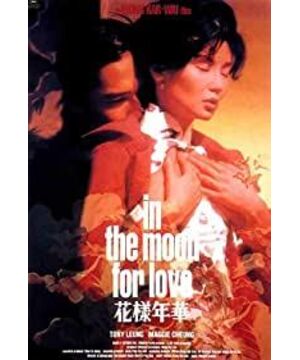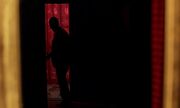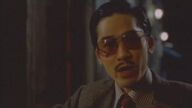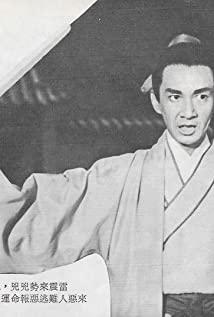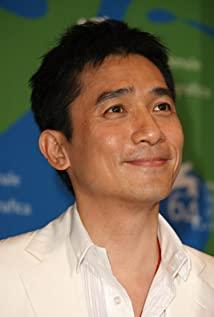The beginning of "In the Mood for Love" depicts such a scene: after the introduction of the subtitles, I heard Wu Nong's soft words in the hustle and bustle. The yellowed frame instantly brings the audience into the atmosphere of Hong Kong with the style of old Shanghai. This arrangement allows the audience to more quickly understand the environment in which the characters are located. After that, Su Lizhen, the protagonist played by Maggie Cheung, pushed in the door, and this was her first clear close-up. In the dim light, Su Lizhen and the landlord were talking about renting a house. When seeing off the guest, the camera moved from the ground to Su Lizhen's face. The face was brightly lit. The use of this camera set the basics for the continued revealing of the characters. Different from the heroine's way of entering the scene by pushing the door directly, after Zhou Muyun, played by Tony Leung, went upstairs from the dim stairs, the camera first fixed on the white light bulb in the room, and then moved down to the dimly lit space, close-up of Zhou Muyun. s face. When Zhou Muyun appeared, Su Lizhen was about to leave. At this time, the camera switched to a panoramic view. The first time the two met was just a simple look at each other. its importance. Immediately, Su Lizhen appeared on the camera, and after Zhou Muyun and the landlord talked, the picture was frozen on the bell. Next is the scene where the two people move. Zhou Muyun and Su Lizhen move at the same time. Here, the director uses a parallel montage method to cut the scene of the two people moving, so that although the moving is hectic in the picture, it is in the audience's eyes. There is no confusion in his eyes, but a sense of balance in the space at the same time. With the development of the plot, in the section where Zhou Muyun asked Su Lizhen to eat at the restaurant, the director did not use too many moving shots and big scenes, but more fixed shots and close-ups. make it just right. This is because the two are sitting face to face, and both want to test each other through dialogue. A large number of close-ups can better highlight the facial expressions of the hero and heroine, so that the audience can understand their inner emotions at this time through the facial expressions of the hero and heroine. . The next scene, I think, is one of the highlights of the film, and it is also a typical Wong Kar-wai thinking style. At the beginning of the picture, Su Lizhen's waist and abdomen have been patted, so that the audience can simulate a feeling of walking. Later, through close-up and close-up of the body movements, eye contact and facial expressions of the two people, the audience can understand that Su Lizhen and Zhou Muyun are imitating Su's husband and Zhou's wife, trying to understand how the two started through imitation. Since Su Lizhen couldn't believe that her husband took the initiative, she and Zhou Muyun imitated it again. The shooting methods and scenes this time are not much different from the first time. I think the director did this to show that in the same time and place in the same place, some things may not be as reasonable as they thought. It should, and people always hope that what they think is right. This film is always full of restraint and prudence, the kind of cautiousness that does not dare to cross the thunder pool, so that Zhou Muyun and Su Lizhen are rarely in the same private space at the same time in the film, and there are only a few short paragraphs. Su Lizhen and Zhou Muyun were writing novels in Zhou Muyun's room. When the landlady returned, Su Lizhen could only be trapped in Zhou's room. When he woke up the next day, Zhou Muyun was lying on the sofa and Su Lizhen was lying on the bed. Here, the director shakes to show the position of the two and the whole scene of the scene.
One of the wonderful things in "In the Mood for Love" is the use of a lot of close-ups, most of which are used to express the emotions of the characters in the play. For example, when filming the conversation between Zhou Muyun and Su Lizhen and their other half, they did not photograph their frontal faces, but photographed close-ups of Zhou and Su's faces to express their emotions. Another example is the close-up of Zhou Muyun's frontal face leaning on the wall, the profile of her face when eating noodles at the noodle stand, the close-up of Lizhen's slippers dropped at Muyun's house, the high-heeled shoes she was wearing and the hand reaching for the slippers, all filled with Strong emotional color. The middle shots are also used more frequently in the film, such as Lizhen's bust and hand holding a thermos bottle, and the shadows of Lizhen and Muyun walking on the wall. A scene worth mentioning is the confrontation between Zhou Muyun and Su Lizhen in the cafe. The close-up of Zhou Muyun's hand when lighting the cigarette and the close-up of Su Lizhen's hand in the coffee mixing cup reveal the secrets of the two people's hearts, indicating that the characters are pretending to be calm and harmonious. The actual inner panic, nuanced.
The main tone of the whole film is dark, and the use of multiple colors also adds a lot of color to the film. The street lights are a little warm yellow. Every time Su Lizhen and Zhou Muyun walk under the street lights in the film, the audience will feel that they both regard each other as their spiritual comfort at this time in their hearts, and it is they who feel warm. And Zhou Muyun and Su Lizhen leaned against the wall as the background, the color is blue-gray, expressing the melancholy and depressed atmosphere of the two at this time. The scene where Su Lizhen went to the hotel to find Zhou Muyun used bright red, whether it was Su Lizhen's windbreaker or the walls and curtains of the hotel, all of which were made of bright red. The reason for the director's use of it is that red represents desire, passion, adventure, etc. And doesn't this color represent Su Lizhen's mood at this moment? She has a desire to be with Zhou Muyun in her heart, and this part of the road is full of passion and adventure. When Zhou Muyun left the Cambodian temple, the director used many colors: the pure dark blue sky background, the dark shadow when Zhou Muyun walked out represents sadness; the temple immersed in gold after leaving symbolizes the sacred, and so on.
Music has always played an irreplaceable role in the film. Adding music to the film can make the content of the film more substantial and the emotions of the characters more full, which is also applicable in "In the Mood for Love". The impressive music in the film is "quizas" (maybe) by NatKing Colo, the American jazz king. This song shows men and women on the emotional road, because they can't choose their love, they fall into an invisible in bondage. The same is true for Zhou Muyun and Su Lizhen in the film. They both like each other but they deeply restrain their feelings for each other because of the shackles of morality and social condemnation. This song is deeply integrated with the content of the film, making the film more infectious and full of tension. Although the song wasn't made for it, it was just right in the movie.
Another highlight of the film is its lines. For example, Zhou Muyun called Su Lizhen when he was about to go to Singapore and said, "It's me, if you have another ticket, will you go with me?" to express his desire to be with Su Lizhen. After Zhou Muyun said these words, the camera cut to him waiting anxiously and then left silently. Then there is the shot of Su Lizhen hurriedly going down the stairs, and the shot of sitting silently on the bed. After a long time, there is a sentence, "It's me, if you have another ticket, will you take me with you?" From Zhou Muyun In the process from saying that sentence to Su Lizhen saying this sentence, no other plot content is added, only the sound of music, which allows the audience to clearly feel that the two people at this time are waiting anxiously, while the other is struggling hard. The lines of this film are very concise, but they do not make people feel monotonous and short, but they are meaningful and unforgettable for a long time, adding a lot to the film.
There are many details in the film worthy of our attention, which can help us better understand Wong Kar-wai's thinking mode. This film is very skilled in terms of scenes, camera movements, color and light use, and it is through the thoughtful use of these aspects that the film "In the Mood for Love" has become a classic. do.
View more about In the Mood for Love reviews


